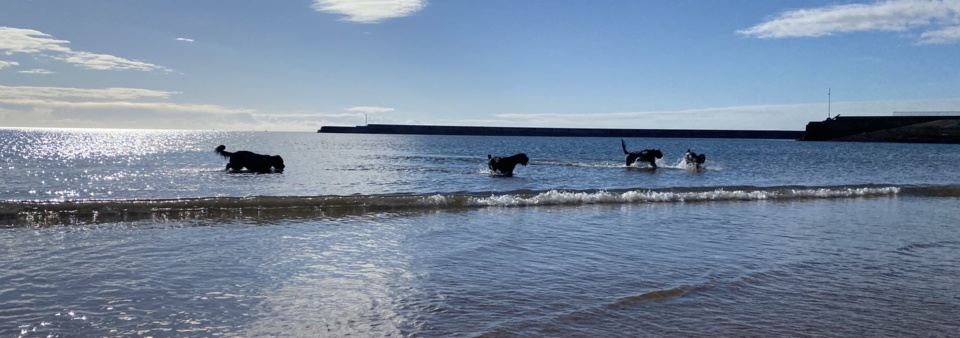
Crucially Canine's Russian Black Terriers
The perfect dog with the perfect training
The Russian Black Terrier (Black Russian Terrier (Russian: Чёрный терьер), abbreviated as BRT, or Stalin's dog (Sobaka Stalina) is a breed of dog developed to serve as guard dog and police
dog. It is rare outside the countries of the former Soviet Union but beginning to be formally recognized elsewhere: 1984 by the FCI, in 1998 by the Kennel Club of Great Britain and in 2004 by the
AKC.
Despite its name, the Russian Black Terrier is not a true terrier: it is believed that about twenty breeds were used in its development, including the Airedale, the Giant Schnauzer, the Rottweiler,
the Newfoundland, the Caucasian Ovtcharka and the now extinct Moscow Water Dog.
The Russian gives the impression of great strength, athleticism, and courage. It should be rustic (but not coarse) in appearance, and should not look as though its coat is sculpted or
trimmed. It should never appear to lack substance or be weak in any way.
The coat is a double coat with an outer guard hair over a softer undercoat. The coat is dense, never soft, woolly, silky or frizzy. It should form a beard and eyebrows on the face, and a slight mane
around the withers and neck that is more pronounced in males. The coat is non- moulting and the colour is black with some grey hairs.
According to the FCI standard the male stands 72 to 76 cm and not more than 78 cm at the withers compared to the female’s 68–72 cm and not more than 74 cm. The male weighs between 50 and 60 kg
(110-132 lbs), and the females weigh between 45 and 50 kg (99-110 lbs). Nowadays, even larger individuals are tolerated if the dog is well proportioned and retains correct movements. At maturity
(over 18 months of age), the AKC standard recommends 27-30 inches for males with the desired height between 27 and 29 inches and 26 and 29 inches for females with the desired height between 26 and 28
inches. A mature male less than 27 inches or more than 30 inches at the withers is considered a serious fault. A mature female less than 26 inches or more than 29 inches at the withers is considered
a serious fault. In proportions a Russian should be slightly longer than tall, a ratio of 9 ½ to 10 being ideal.
Russians are confident, calm, highly intelligent, brave and loyal. It should never be timid. The Russian may seem aloof, but needs human companionship and bonds deeply to its family.
The Russian, because of its breeding as a working dog, has a very strong "work ethic", it needs a job to do in order to be happy. Early training is a must and they are very responsive to consistent
positive based training. Russians will accept punishment in training from someone it trusts as long as the punishment is fair and consistent. Russians excel at Obedience competitions. They also
perform well in other dog sports, such as Agility, and Schutzhund training. Dogs who compete in conformation need to be groomed a minimum of every 6 weeks to keep the coat in show condition. The
Russian can handle lots of exercise, you will never over exercise a mature dog, they will never want to stop learning and if you fulfil this they will never want to be anywhere but at your side or
laying at your feet as you watch the world go by.
The Russian is a generally healthy and a somewhat long-lived dog for their size (lifespan of 10–14 years), however it is prone to certain hereditary diseases:
Hip dysplasia
Elbow dysplasia
Hyperuricosuria
Progressive retinal atrophy (PRA)
If you choose to acquire your Russian from a breeder other than Crucially Canine it is extremely important to screen any potential breeders as well as their breeding stock. A well-intended breeder
will have all health checks on all breeding stock before making the decision to breed their dogs. While health checks on breeding stock cannot guarantee a puppy will not develop any health issues
later on, it is important to "do your homework" on any potential breeder.
